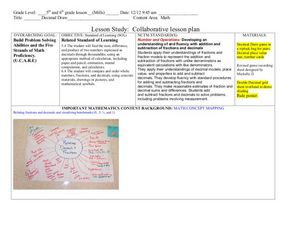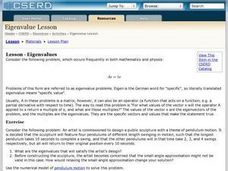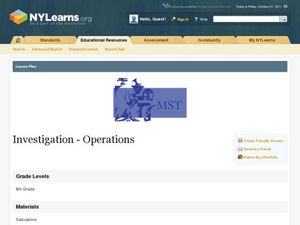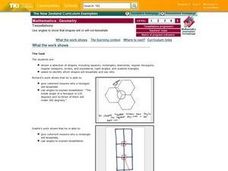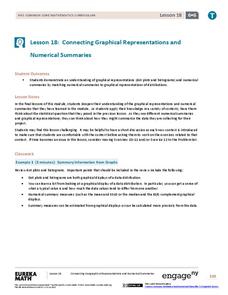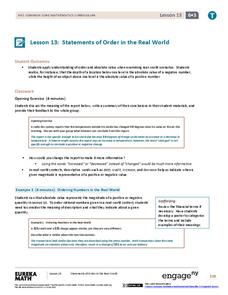Curated OER
Tangram Perimeters
Students work together to make figures out of tangram squares. In groups, they calculate the measurements they need and apply the Pythagorean Theorem. They complete a worksheet solving equations using the theorem and review their answers.
Curated OER
Noughts
Students try to figure out the strategies to the game Noughts. Students logic must play a part in the process of the game. Students apply the symmetries of regular polygons. Students devise ways to critically follow a chain of reasoning.
Curated OER
The Old Chicken Run Problem
Sixth graders apply problem solving strategies to work with a real life situation in which they need to determine the area. They determine the area of chicken runs that are rectangular in shape when give a partial perimeter.
Curated OER
Decimals: Collaborative Lesson
Learners explore mathematics by participating in a group activity. In this number value lesson, students identify the uses for decimals and how to best estimate whole numbers based on decimals and fractions. Learners collaborate with...
Curated OER
Sonics Math
Young scholars multiply whole numbers by fractions. They see one way that decimals apply to the real world, and possibly consider more.
Curated OER
Probability: the Study of Chance
Young scholars experiment to determine if a game is fair, collect data, interpret data, display data, and state and apply the rule for probability. Students use a simple game for this experiment.
Curated OER
Create A Question
Students explore mathematical problem solving. Given a case problem, students write a rule to solve problems involving decimal multiplication and division. They invent problems, share them with the class, and solve other student's...
Curated OER
Make the Highest Total
Sixth graders predict the outcome of a simple probability experiment, test it and explain the result by using problem solving strategies to explore situations mathematically. They then play a few games informally where students play in...
Curated OER
Someone Is In The Kitchen
Students investigate the lifestyles of the Native Americans and look at a recipe found on a website. They read the recipe and pay attention to the measurements. They differentiate between the various measures in order to apply them to...
Curated OER
Sunrise/Sunset
Learners apply data from a weather-related website to predict patterns in the sunrise and sunset.
Curated OER
"If You Hopped Like a Frog" by David M. Schwartz
Learners brainstorm several animal/personal scenarios, select one, and write out an explanation of the comparison. They apply the measurements/characteristics to themselves and use algebraic equations to demonstrate the comparison.
Curated OER
Physics: Eigenvalues
Students solve problems by discovering the eigenvalues that satisfy design questions. They explain how relaxing a small angle approximation can change the solution. Students apply the numerical model of pendulumm motion to solve the...
Curated OER
Polygonal Strings
Sixth graders apply knowledge of how to calculate the area and perimeter of triangles. They determine why it is inappropriate to measure the area of land by its perimeter which is done in certain areas of New Guinea. They complete a...
Curated OER
Math: Reaching New Heights
Students apply math skills to assess the range, mean, mode, and median of data sets. Using a "Reaching New Heights" worksheet, they review and discuss how to calculate the answers. Students write complete explanations of all their...
Curated OER
Investigation-Operations
Sixth graders explore equations. For this math lesson, 6th graders discuss the rules for solving equations. Students apply the rules and solve various equations.
Curated OER
Multiples of a
Sixth graders use problem solving strategies to evaluate linear expressions by substituting values. They substitute values for the letters in their names before applying the concept to other words. They complete worksheets in which they...
Curated OER
Parks Design Project
Pupils explore two dimensional geometric figures. They explore the relationships and measurements of geometric figures. Students apply proportion and scaling. They design a city park for pupils and teenagers.
Curated OER
Tessellations: Use Angles To Show That Shapes Will or WIll Not Tessellate
Students observe a selection of shapes. They identify which shapes will tessellate and justify their answer. Students apply the symmetry and angle properties of polygons to create tessellations.
EngageNY
Least Common Multiple and Greatest Common Factor
Find the common denominator between prime factors, factor trees, and the distributive property. Scholars learn to find the least common multiple and greatest common factor of pairs of numbers. They rotate through stations to connect...
EngageNY
Divisibility Tests for 3 and 9
Who knew the sum of a number's digits gives such interesting information? The 18th installment of a 21-part module has scholars investigate division by three and nine. After looking at several examples, they develop divisibility tests...
EngageNY
Connecting Graphical Representations and Numerical Summaries
Which graph belongs to which summary statistics? Class members build upon their knowledge of data displays and numerical summaries to connect the two. Pupils make connections between different graphical displays of the same data in...
Virginia Department of Education
Using Order of Operations and Exploring Properties
If you need some creative ways to teach the order of operations, use a series of activities that focus on properties. Each lesson uses different materials and works as a stand-alone activity, or can build upon the concepts of the last...
EngageNY
Creating Division Stories
Create your own adventure story ... well, not really. The fifth lesson in a 21-part series has pairs create story contexts for division problems. The lesson presents a step-by-step process for pupils to follow in writing such stories.
EngageNY
Statements of Order in the Real World
Positive and negative numbers are all around us. Groups read short story contexts and identify a rational number that represents the values in the context. They order the rational numbers and interpret statements of inequality.



